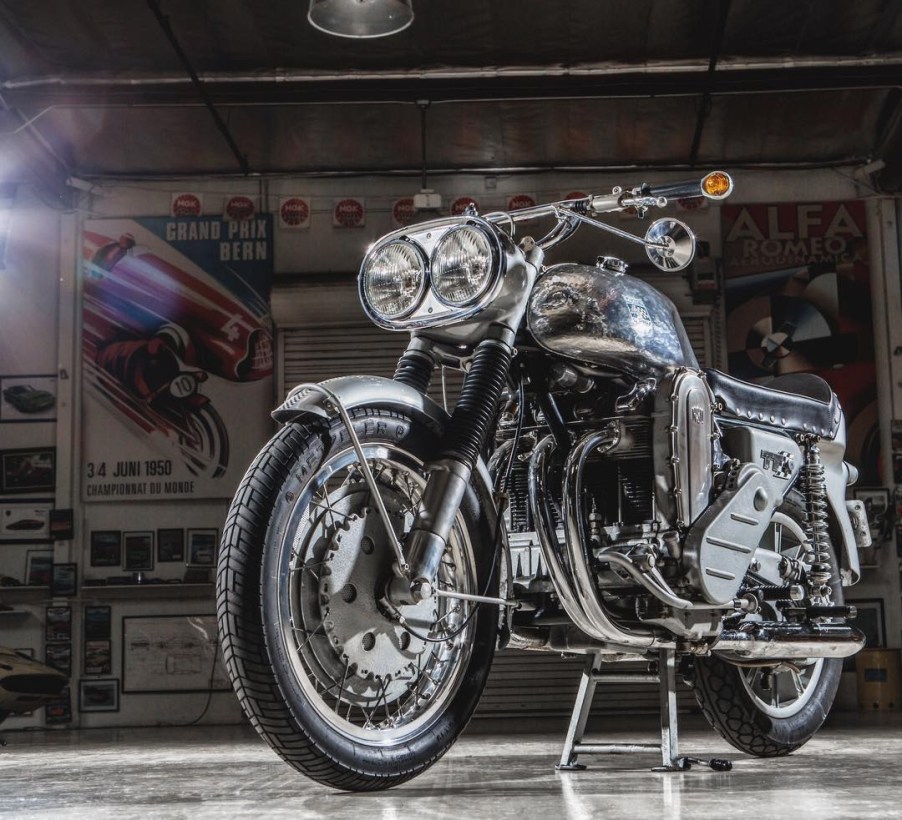
The Munch Mammut Was the Bugatti Veyron of 1960s Bikes
While the Bugatti Veyron isn’t exactly practical, as a feat of engineering, it’s extremely impressive. And while the list of motorcycles that can even approach 200 mph is extremely short, some at least match the Veyron’s engineering effort. Especially when it comes to massive engines. The Lazareth LM847, for instance, was a 4-wheeled motorcycle with a 4.7-liter Maserati V8. But there have been other motorcycles built using car engines. And one of the early ones was the Munch Mammut.
What is the Munch Mammut?

Friedl Munch, RideApart reports, already had an extensive motorcycling career by the mid-60s. He’d raced for German motorcycle Horex before it went bust, and subsequently bought out its remaining stock of bikes and parts, Revivaler reports.
Rather like Brough Superior’s George Brough, Munch had a fascination with engineering and speed. That’s why, Silodrome explains, French sidecar racer Jean Murit approached him to build the world’s most powerful production motorcycle. And in 1965, the Munch Mammut (German for ‘Mammoth’) debuted.
The name was rather appropriate. At the core of the Munch Mammut is a 996cc four-cylinder engine taken from the NSU Prince. The Mammut wasn’t the first car-engine bike, Automobile Magazine reports, but it was still an extremely large engine for its time. And it actually grew larger over time, Bonhams reports.
The 1965 version was really more of a prototype. By the time the production version debuted in 1966, the Munch Mammut had a 1085cc four-cylinder, which put out 70 hp and gave it a roughly 140-mph top seed. 1973 saw an even larger engine, a 104-hp 1177cc four-cylinder that made the Mammut the first fuel-injected production bike. The Vincent Black Lightning was still slightly faster, topping out at 150 mph. But it shows the Bugatti Veyron comparison isn’t totally hyperbole.
And like the Veyron, the rest of the Munch Mammut also required extensive design work. The frame was an extensive rework of the North Featherbed frame, one of the best available at the time. Because the larger NSU engines were powerful enough to break the rear wheel spokes, a new magnesium one had to be made. And although the Mammut still used drum brakes, the front was 10” in diameter.
What’s the Munch Mammut like to ride?
Despite the car engine and 2 batteries, the Munch Mammut actually doesn’t weigh as much as you might think. Thanks to the extensive use of magnesium, it weighs about 480 pounds. There are several modern Harley-Davidsons and BMW bikes that weigh significantly more. Motorcycle Classics reports the Mammut’s easy to ride, even at low speeds. The suspension is also fairly comfortable, The Vintangent reports. And, as Jay Leno reports, it’s also remarkably smooth.
True, the Munch Mammut’s power meant it chewed through rear tires very quickly. But Leno says that Mammut owners could ride their bikes at over 100 mph “for hours on end.” Doing ‘the ton’ was quite an accomplishment back then, even for high-performance café racers. And even after 30 years of ownership, Leno reports his 1966 Munch Mammut has been fairly trouble-free.
Pricing and availability
The Munch Mammut also took after the Bugatti Veyron in one more respect: price. In today’s dollars, a Munch Mammut would set you back about $30,000. To put that in perspective, a top-trim BMW /6 series would cost less than $12,000. Less than 500 were made, and RideApart estimates only 320 survive.

Friedl Munch did attempt to bring the Mammut back, Cycle World reports, in 2000. The Munch Mammut 2000 used an even bigger engine, a 260-hp 1998cc turbocharged four-cylinder developed by Cosworth. It was also suitably modern, with Ohlins forks and disc brakes, and a top speed over 150 mph. However, it cost $82,000; only 15 were made before the company folded.

Today, classic Mammuts are collectible bikes. Bonhams sold a 1177cc 1970 example in 2018 for the equivalent of $193,904. The following year, a 1974 model went for $112,000 at the Las Vegas Motorcycle Auction.
But even if you never ride a Munch Mammut, you have to admire the effort put into making it.
Follow more updates from MotorBiscuit on our Facebook page.


